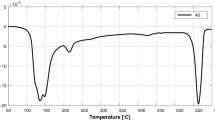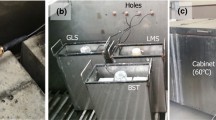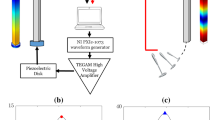Abstract
In this work, a nondestructive evaluation technique (NDE) based on nonlinear impact resonance acoustic spectroscopy (NIRAS) is applied to the assessment of mortar and concrete damage caused by the sulfate attack and freeze–thaw cycles. The nonlinear parameter is defined as the relative shift of resonance frequency against the vibration acceleration magnitude and compared with traditional parameter (i.e. linear resonance frequency) for damage characterization. The nonlinear parameter increases with the development of sulfate attack damage in mortar samples and presents a positive correlation with the expansion results in the standard accelerated experiments, indicating the feasibility of NIRAS technique in assessment of sulfate attack damage. The experimental results also validate the sensitivity of NIRAS technique to sulfate attack damage. The nonlinear parameter increases about 140 % and 3700 % after 2 and 3 months of sulfate solution exposure, while the linear resonance frequency changes about 5 % and 24 %, respectively. On the other hand, the nonlinear parameter shows a monotonically increasing trend for concrete samples subjected to increased freeze–thaw cycles and presents an appreciable distinction for samples having different capillary water. The nonlinear parameter of concrete samples with 0.55 w/c ratio is about 10 times that of concrete samples with 0.45 w/c ratio after 150 freeze–thaw cycles. The experimental results in this paper demonstrate that the developed NIRAS technique not only can be used a good NDE method for damage assessment of cement-based materials caused by durability problem such as sulfate attack and freeze–thaw cycles, but also has the potential to reveal the variation of microstructural characteristics of materials such as the microcracking development and moisture content change.











Similar content being viewed by others
References
Mehta PK, Monteiro PJM (2005) Concrete: microstructure, properties and materials, 3rd edn. McGraw-Hill Publisher, New York
Aggelis DG (2013) Wave propagation through engineering materials; assessment and monitoring of structures through non-destructive techniques. Mater Struct 46:519–532
ASTM International (2002) ASTM C 597—standard test method for pulse velocity through concrete. West Conshohocken, Pennsylvania
ASTM International (2003) ASTM E 2001—Standard Guide for resonant ultrasound spectroscopy for defect detection in both metallic and non-metallic parts. West Conshohocken, Pennsylvania
Popovics S, Rose JL, Popovics JS (1990) The behavior of ultrasonic pulses in concrete. Cem Concr Res 20:259–270
Warnemuende K, Wu HC (2004) Actively modulated acoustic nondestructive evaluation of concrete. Cem Concr Res 34:563–570
Yim HJ, Kwak H-G, Kim JH (2012) Wave attenuation measurement technique for nondestructive evaluation of concrete. Nondestruct Test Eva 27:81–94
Ohtsu M (2011) Damage evaluation in freezing and thawing test of concrete by elastic-wave methods. Mater Struct 44:1725–1734
Zhou C, Li K, Han J (2012) Characterizing the effect of compressive damage on transport properties of cracked concretes. Mater Struct 45:381–392
Shiotani T, Aggelis DG (2009) Wave propagation in cementitious material containing artificial distributed damage. Mater Struct 42:377–384
Kim J-Y, Jacobs LJ, Qu J, Littles JW (2006) Experimental characterization of fatigue damage in a nickel-base superalloy using nonlinear ultrasonic waves. J Acoust Soc Am 120:1266–1273
Liu Y, Chillara VK, Lissenden CJ, Rose JL (2013) On selection of primary modes for generation of strong internally resonant second harmonics in plate. J Sound Vib 332:4517–4528
Lissenden CJ, Liu Y, Choi G, Yao X (2014) Effect of localized microstructure evolution on higher harmonic generation of guided waves. J Nondestruct Eval 133:178–186
Shui GS, Wang YS, Huang P, Qu JM (2015) Nonlinear ultrasonic evaluation of the fatigue damage of adhesive joints. NDT&E Int 70:9–15
Donskoy D, Sutin A, Ekimov A (2001) Nonlinear acoustic interaction on contact interfaces and its use for nondestructive testing. NDT&E Int 34:231–238
Van Den Abeele KE-A, Johnson PA, Sutin A (2000) Nonlinear elastic wave spectroscopy techniques to discern material damage, part I: nonlinear wave modulation spectroscopy (NWMS). Res in Nondestruct Eva 12:17–30
Shah AA, Ribakov Y, Zhang Ch (2013) Efficiency and sensitivity of linear and non-linear ultrasonics to identifying micro and macro-scale defects in concrete. Mater Design 50:906–916
Shah AA, Ribakov Y (2013) Non-linear ultrasonic evaluation of damaged concrete based on higher order harmonic generation. Mater Design 30:4095–4102
Chen J, Xu Z, Yu Y, Yao YP (2014) Experimental characterization of granite damage using nonlinear ultrasonic techniques. NDT&E Int 67:10–16
Chen J, Jayapalan AJ, Kurtis KE, Kim JY, Jacobs LJ (2009) Nonlinear wave modulation spectroscopy method for ultra-accelerated ASR assessment. ACI Mat J 106:340–348
Chen J, Jayapalan AJ, Kurtis KE, Kim JY, Jacobs LJ (2010) Rapid evaluation of alkali-silica reactivity of aggregates using a nonlinear resonance spectroscopy technique. Cem Concr Res 40:914–923
Chen J, Kim JY, Kurtis KE, Jacobs LJ (2011) Theoretical and experimental study of the nonlinear resonance vibration of cementitious materials with an application to damage characterization. J Acoust Soc Am 130:2728–2737
Payan C, Garnier V, Moysan J (2007) Applying nonlinear resonant ultrasound spectroscopy to improving thermal damage assessment in concrete. J Acoust Soc Am 121:EL125–130
Antonaci P, Bruno CLE, Gliozzi AS, Scalerandi M (2010) Monitoring evolution of compressive damage in concrete with linear and nonlinear ultrasonic methods. Cem Concr Res 40:1106–1113
Antonaci P, Bruno CLE, Bocca PG, Scalerandi M, Gliozzi AS (2010) Nonlinear ultrasonic evaluation of load effects on discontinuities in concrete. Cem Concr Res 40:340–346
Cantrell JH (2004) Fundamentals and applications of nonlinear ultrasonic nondestructive evaluation. In: Kundu T (ed) Ultrasonic nondestructive evaluation: engineering and biological material characterization, 1st edn. CRC Press, Boca Raton, pp 363–433
Landau LD, Lifshitz EM (1986) Theory of elasticity, 3rd edn. Butterworth-Heinemann, Oxford
Nagy PB (1998) Fatigue damage assessment by nonlinear ultrasonic material characterization. Ultrasonics 36:375–381
Guyer A, Johnson PA (1999) Nonlinear mesoscopic elasticity: evidence for a new class of materials. Phys Today 52:30–35
Johnson PA, Sutin AM (2005) Slow dynamics and anomalous nonlinear fast dynamics in diverse solids. J Acoust Soc Am 117:124–130
Chen J, Zhang L (2015) Experimental study of effects of water-cement ration and curing time on nonlinear resonance of concrete. Mater Struct 48:423–433
ASTM International (2015) ASTM C 1012: standard test method for length change of hydraulic-cement mortars exposed to a sulfate solution. West Conshohocken, Pennsylvania
Chinese Cement Standard (2007) Common portland cement (GB175-2007). Chinese Standard Publishing, Beijing
European Standard (2011) Cement. Composition, specifications and conformity criteria for common cements (BS EN 197-1:2011). European Committee for Standardization, Brussels
Penttala V, Al-Neshawy F (2002) Stress and strain state of concrete during freezing and thawing cycles. Cem Concr Res 32:1407–1420
Chen J, Ren J, Yin T (2016) Nondestructive evaluation of notched cracks in mortars by nonlinear ultrasonic technique. Nondestruct Test Eval 31:109–121
Payan C, Garnier V, Moysan J (2010) Effect of water saturation of porosity on the nonlinear elastic response of concrete. Cem Concr Res 40:473–476
Kim JY, Lee JS (2007) A micromechanical model for nonlinear acoustic properties of interfaces between solids. J Appl Phys 101: Art. # 043501
TenCate JA, Smith E, Guyer RA (2000) Universal slow dynamics in granular solids. Phys Rev Lett 85:1020–1023
Guyer RA, McCall KR, Van Den Abeele K (1998) Slow elastic dynamics in a resonant bar of rock. Geophys Res Lett 25:1585–1588
Bentahar M, El Aqra H, El Guerjouma R, Griffa M, Scalerandi M (2006) Hysteretic elasticity in damaged concrete: quantitative analysis of slow and fast dynamics. Phys Rev B 73:014116
Acknowledgments
The authors gratefully acknowledge the support from National Natural Science Foundation of China (Grant No.51308020 and 512778517), Major Fundamental Research of China (973 Program, Grant No. 2014CB047003) and Beijing Natural Science Foundation (Grant No. 8162027).
Author information
Authors and Affiliations
Corresponding author
Rights and permissions
About this article
Cite this article
Chen, J., Bharata, R., Yin, T. et al. Assessment of sulfate attack and freeze–thaw cycle damage of cement-based materials by a nonlinear acoustic technique. Mater Struct 50, 105 (2017). https://doi.org/10.1617/s11527-016-0949-7
Received:
Accepted:
Published:
DOI: https://doi.org/10.1617/s11527-016-0949-7




